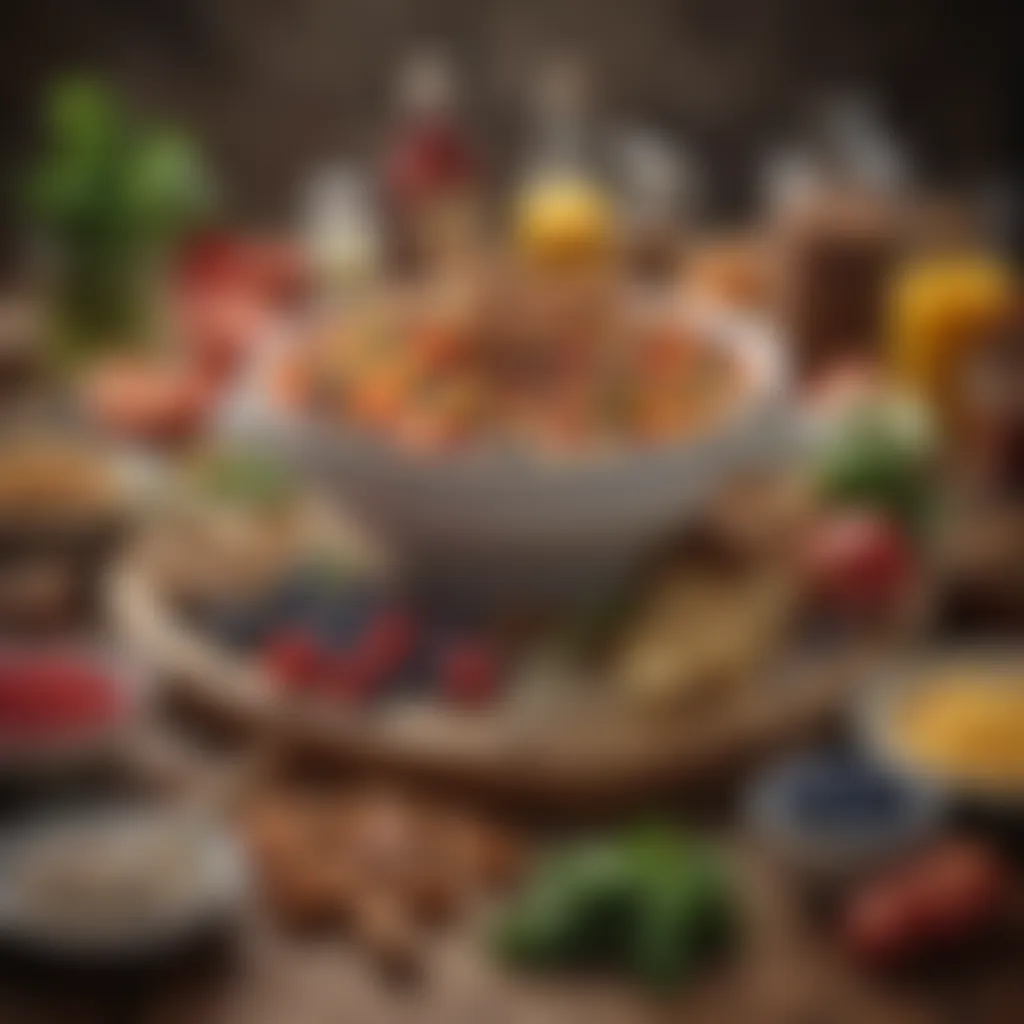Crafting Culinary Delights from Nursery Rhymes


Intro
Crafting recipes inspired by nursery rhymes is an intriguing nexus between childhood whimsy and culinary artistry. These simple yet profound verses encapsulate vivid imagery often evoking delightful sensory experiences, making them perfect for inspiration in the kitchen. A nursery rhyme, by its nature, tells a story through rhythm and rhyme, often featuring common ingredients or whimsical situations that can be transformed into delightful dishes. In this journey, we will not only explore the intricate process of crafting these recipes but also appreciate the rich narratives embedded in each rhyme.
As we embark on this culinary adventure, we'll provide you with thoughtful guidance, practical tips, and hands-on steps to breathe life into beloved nursery rhymes. From gathering ingredients to relishing the final product, each stage will unfold like a perfectly rhymed couplet. As you stir, bake, and taste, you'll find that these nursery-inspired recipes do more than fill the belly; they nurture creativity and encourage storytelling at the dinner table.
Before we dive into creating our own nursery rhyme recipes, let’s gather the essential ingredients. This list reflects classic ingredients often found in nursery rhymes, preparing us for a wholesome and engaging cooking session.
The Historical Background of Nursery Rhymes
The study of nursery rhymes goes beyond mere entertainment for children; it serves as a gateway into the cultural and historical fabric of societies across the globe. Understanding the historical background of nursery rhymes can reveal the long-standing traditions, values, and communication styles of different communities and how these have seeped into the culinary realm. Recognizing how these rhymes emerged and evolved provides a foundation for appreciating their role in shaping language, culture, and now even recipes.
Origin and Evolution
Nursery rhymes have a rich tapestry of origins that date back centuries. Some of these whimsical verses can be traced to medieval times, with roots in folk tales, children's games, and community storytelling. Originally, they were part of an oral tradition that passed knowledge, morals, and cultural heritage from one generation to the next. For instance, "Ring a Ring o' Roses" is believed to have originated during the Great Plague, serving both as a playful rhyme and a subtle acknowledgment of a grim reality.
As society evolved, so did the nursery rhymes. They transitioned from mere stories into structured poems, incorporating rhythm and rhyme, thus making them easy to remember and recite. An example of this transformation is seen in the infamous "Hey Diddle Diddle." It highlights the engaging and whimsical nature of children's literature while uncovering social insights from the period it reflects, including class and gender dynamics. The ability to adapt and resonate with children across ages speaks to the timeless nature of these rhymes.
Cultural Context and Significance
The cultural significance of nursery rhymes is profound. They often mirror the values, hopes, and anxieties of the times they come from. An examination of a particular nursery rhyme can reveal much about social structures, norms, and events of that era. For instance, "Baa Baa Black Sheep" raises questions about labor, trade, and class systems, offering a peek into the economic practices of the 18th century.
Moreover, nursery rhymes can foster social connections. Parents and children bond while sharing these rhythmic verses, thus passing down traditions and fostering a sense of belonging. They also serve as valuable tools in language development, enhancing vocabulary and comprehension skills in a fun way. In crafting nursery rhyme recipes, one can tap into this cultural wealth, drawing inspiration for dishes that resonate personally or culturally.
Transition from Oral Tradition to Written Form
The shift from oral to written traditions solidified the nursery rhyme as a staple in early childhood literacy. The advent of printing in the 17th century was pivotal; it allowed these rhymes to spread far beyond their localized origins. This was highlighted in collections like "Mother Goose’s Melodies," which compiled numerous nursery rhymes and brought them into the hands of many families.
With print came the opportunity to standardize, yet individual interpretations remained common, allowing for local variations of various rhymes. The written form also opened doors for illustrations, enhancing their appeal and aiding in storytelling. Consequently, parents began using these printed rhymes as teaching tools—cooking and crafting with children became an extension of the rhymes' playful spirit. The culinary world could benefit immensely from this journey, as revisiting those rhymes while concocting a dish makes the kitchen feel like a whimsical wonderland.
In blending these lyrical histories with cooking, we can appreciate not only the richness of nursery rhymes but also their adaptability in modern contexts. By understanding the historical roots, we can elevate the experience of crafting nursery rhyme recipes beyond just food preparation, creating a resonant experience filled with stories, memories, and joy.
Linguistic Features of Nursery Rhymes
Nursery rhymes are not just playful verses for children; they are intricate linguistic constructs that offer various benefits in enhancing language skills and creative cooking. Focusing on linguistic features helps us further appreciate how these artful expressions can translate into culinary adventures. The elements within nursery rhymes—such as rhythm, imagery, and phonetics—play a pivotal role in engaging young minds. This connection emphasizes the enduring impact they can have on both learning and creativity.
Rhythm and Rhyme Schemes
The rhythm and rhyme schemes of nursery rhymes are foundational to their charm. The predictable pattern of sounds fosters a sense of fun that captures children's attention. Take "Twinkle, Twinkle, Little Star," for instance. The repetition of sounds helps young listeners internalize language structures, making it easier for them to recall words later on.
In the kitchen, this rhythm can inspire a similar cadence when cooking. For example, a recipe might include a rhythmic sequence of steps:
- Chop, chop, chop! Cut veggies fine.
- Mix it up! Add spices divine.
- Stir, stir, stir! Cook 'til it’s done.


Utilizing these rhythmic phrases when reading recipes not only maintains engagement but also helps with memory retention and recall, allowing families to have fun cooking together.
Imagery and Symbolism
Imagery and symbolism within nursery rhymes help bring abstract ideas to life. A rhyme may use simple words to evoke rich visual landscapes. Think of "Mary Had a Little Lamb"—the daughter and her lamb create a vivid, pastoral scene that translates into a thematic dish filled with lamb and fresh vegetables.
The use of such imagery can be creatively employed in the kitchen by presenting dishes in similar ways. For example, a pumpkin soup could be sold as “Mary’s Autumn Harvest,” where the warm colors and cozy texture bring forth comfort just like the poem itself. This connection encourages families to explore culinary creativity by allowing them to visualize flavors through the lens of nursery rhymes.
Phonetics and Sound Play
Phonetics and sound play are key to the playful nature of nursery rhymes. The deliberate choice of words, sounds, and alliterations makes rhymes catchy and easy to remember. Consider the classic tale of "Hickory Dickory Dock." The repetition of consonants and the rhythmic flow create a musicality that appeals to the ear.
In cooking, sound play can be harnessed by using fun names for dishes or playful meal preparation instructions. Instead of a regular cooking phrase, one might title a cookie recipe as "Whisk, Whisk, Hooray!" This playful use of phonetics enhances the cooking experience, while also being a delightful way to engage children.
"Nursery rhymes are key portals into learning, fostering not just language acquisition but also framing our culinary experiences through creativity and play."
Infusing Creativity into Cooking
Creativity in cooking isn't just about setting aside the recipe and throwing ingredients together haphazardly. It’s more like painting on a canvas, where each dish tells a story and flavors create a symphony that intrigues and delights the palate. Infusing creativity into cooking, especially through the lens of nursery rhymes, opens the door to a unique culinary experience. By marrying the whimsical world of rhymes with the practicalities of cooking, we craft dishes that resonate not just in taste but in memory and imagination.
Imagining Dishes Through Verse
When we think of nursery rhymes, vibrant images come to mind—colorful characters, enchanting tales, and sometimes even whimsical food. Imagine transforming these verses into delightful dishes! For example, the classic “Hey Diddle Diddle” conjures images of a cat playing a fiddle and a cow jumping over the moon, providing a perfect springboard for creative culinary exploration. One could whip up a whimsical dessert that reflects the themes of the rhyme—perhaps a moon-shaped cake paired with a creamy filling that evokes the night sky.
Crafting these dishes requires a blend of inspiration and intuition. As one taps into the playful storytelling of nursery rhymes, they can draw inspiration for flavors, colors, and textures that might otherwise go unnoticed in everyday cooking. Here are a few tips:
- Visualize the Verse: Picture the story unfolding as you create each dish, letting the imagery guide your ingredient choices.
- Choose Colorful Ingredients: Use vibrant fruits and vegetables that reflect the playful essence of the rhyme.
- Mythical Pairings: Think outside the box—pair unexpected flavors that narrate your own culinary tale while staying true to the spirit of the rhyme.
The Role of Playfulness in Cookery
Engaging with nursery rhymes in the kitchen is about more than just creating food; it's about encouraging a playful mindset. This playfulness fosters an environment where both kids and adults can experiment fearlessly.
It’s the kind of setting where mistakes are simply learnings in disguise. When whipping up a dish inspired by the rhyme "This Little Piggy," for instance, one could embrace creativity by turning the conventional idea of roast pork into playful finger food—miniature pork sliders served with a selection of dips. While cooking, this notion of playfulness keeps the atmosphere light and inviting, allowing for laughter and joy, making cooking less of a chore and more of an adventure.
"Cooking is about creating joy as much as it is about nourishment. Infusing creativity through nursery rhymes makes every meal a celebration."
The act of playing with food doesn’t just yield innovative options but significantly enhances the learning experience for children involved in the kitchen. Allowing them to express their interpretation of a rhyme through food encourages development in creativity, fine motor skills, and critical thinking. It’s this blend of fun and function—where lessons hide beneath layers of laughter and creativity—that makes infusing playful elements into cooking an invaluable practice.
In summary, by diving into nursery rhymes and allowing them to inspire dishes, we can harness a creative spark that revitalizes the mundane kitchen routine. This approach not only breathes new life into our cooking but also strengthens family bonds through shared stories and experiences, making each meal a cherished memory.
Case Studies of Nursery Rhyme Recipes
Exploring case studies related to nursery rhyme recipes can unveil the many layers behind culinary creativity. These examples offer a pathway to understanding how familiar verses can influence the way we cook and eat. By looking at both traditional recipes and their modern adaptations, one can appreciate the seamless blend of storytelling and gastronomy. This intersection not only fuels imagination in the kitchen but can also contribute to the education of young children.
Analyzing Traditional Recipes


Traditional nursery rhymes have been transformed into recipes that retain their original charm while adding a culinary twist. For instance, the well-loved rhyme "Hey Diddle Diddle" can inspire a delightful dish featuring dairy, as the rhyme conjures images of milk and playful cats. Think of a creamy cheese casserole that mirrors the whimsy of the verse.
"Food, like stories, serves as a bridge between generations."
By analyzing these traditional recipes, we can identify specific motifs or ingredients mentioned in the rhymes. Often, these dishes are simmered in family stories, cultural practices, and the sounds of laughter around the dinner table. Each recipe becomes a nod to the past, providing a sensory experience that connects children to the wisdom of their forebears. When whipping up these culinary delights, one learns to appreciate not just the taste, but the history that makes these recipes special.
Contemporary Adaptations
In today's fast-paced world, we see a growing trend of adapting nursery rhymes to fit modern palates and lifestyles. This might mean crafting a gluten-free version of a classic dish inspired by a rhyme. For example, "Ring a Ring o’ Roses" can spark ideas for a vibrant salad featuring fresh roses, greens, and a splash of citrus dressing.
These contemporary adaptations are not just about altering ingredients. They celebrate the spirit of the original rhymes while catering to current dietary preferences and cooking methods. It opens doors for parents to introduce their children to healthy eating through familiar verses. The rhythmic patterns of nursery rhymes lend themselves well to memory, making it easier for kids to participate in the cooking process.
- Benefits of contemporary adaptations include:
- Encouraging healthier eating habits
- Facilitating family bonding time in the kitchen
- Allowing for creative expression through food
- Showing how tradition can evolve without losing its essence
By diving into these case studies—both traditional and contemporary—cooks can unlock a world where nursery rhymes are not merely child’s play, but a rich canvas for culinary exploration.
The Educational Potential of Nursery Rhyme Cooking
When we think about nursery rhymes, we often envision simple melodies and rhythmic verses aimed at entertaining children. However, there’s a treasure trove of educational benefits nestled within these playful verses, especially when they transition into the culinary realm. Nursery rhyme cooking not only stimulates a child’s imagination but also engages various learning facets, turning meal preparation into an interactive, holistic educational experience.
Facilitating Language Acquisition
Engaging with nursery rhymes in a cooking context can serve as a powerful tool for fostering language skills among young children. The rhythmic patterns found in these verses make it easier for children to grasp new vocabulary and understand pronunciation. As children recite these rhymes while mixing ingredients or measuring flour, they connect actions with words. This active participation enhances their language skills in an enjoyable way.
For instance, a cooking activity based on "Jack and Jill" can introduce verbs like “climb,” “fill,” and “spill.” Additionally, children learn to associate sounds, enabling better phonetic awareness, which is crucial for reading.
"Cooking with nursery rhymes helps solidify linguistic concepts in a fun atmosphere, making it easier for kids to learn and remember."
Developing Numeracy and Measurement Skills
Cooking inherently involves various measurements and counting, perfectly aligning with the development of numeracy. By using nursery rhymes, children can learn concepts of quantity, time, and sequence in a real-world context. For instance, while following a recipe inspired by "The Itsy Bitsy Spider," children can measure ingredients, learning fractions and volume.
Here are some ways nursery rhyme cooking can promote numeracy:
- Counting: Counting out spoonfuls of sugar or cups of milk.
- Estimating: Guessing how many pieces of fruit it takes to fill a bowl.
- Understanding Units: Learning about tablespoons vs. teaspoons and other unit measurements.
By integrating nursery rhymes into culinary activities, not only do kids enhance their math skills, but they also gain confidence in applying these skills outside the classroom.
Encouraging Creativity in Young Minds
The charm of nursery rhymes lies in their imaginative narratives. When kids cook inspired by these verses, they harness that imagination to create unique culinary masterpieces. This creative engagement allows children to make choices about ingredients, presentation, and even the flavors they wish to blend together.
For example, a recipe based on "Old MacDonald Had a Farm" could involve letting kids choose from a variety of vegetables for a colorful salad, promoting artistic expression through food. This exploration of creativity nurtures not just their cooking skills but also their ability to think outside the box in other facets of life.


In the kitchen, they learn to problem-solve – like figuring out how to use up leftover ingredients or adapting a recipe to suit their tastes, making the experience both educational and empowering.
In summary, nursery rhyme cooking is an engaging, multifaceted approach to learning that can significantly enhance early childhood education. Children learn vital language and numeracy skills while fostering imagination and creativity in the kitchen. Encouraging this type of learning environment allows both parents and children to enjoy quality time together while reaping the developmental benefits.
Emotional and Psychological Impact
The emotional and psychological effects of engaging with nursery rhyme recipes stretch far beyond merely whipping up a dish. When we consider the rich tapestry of childhood memories woven through nursery rhymes, we see that these verses carry significant weight in shaping our culinary experiences and family relationships. The act of recalling these rhymes while cooking invokes a sense of nostalgia that can bridge generational gaps, creating a shared space where grandparents, parents, and children unite over a common fondness for familiar tunes and flavors.
Culinary Memories from Childhood
Turning to the kitchen often brings back vivid memories from youth. The aroma of freshly baked goods mingling with the playful snippets of nursery rhymes can awaken delightful recollections of family gatherings, birthday celebrations, and those lazy Sunday afternoons. For instance, consider a simple recipe for sweet potato pie, which might remind someone of a Saturday spent with a grandmother, mouth agape as she sang "This Old Man" while preparing the crust. Such moments cement a connection to food that isn't merely biological but deeply emotional.
"Food is our common ground, a universal experience." — James Beard
Pursuing this connection can have immense psychological benefits. Engaging with recipes inspired by nursery rhymes can evoke feelings of safety and warmth. It’s in this enchanted blend of food and verse where children first learn the joy of cooking and sharing meals. A chocolate chip cookie recipe aligned with the rhyme 'Hickory Dickory Dock' can transform a mundane baking session into a delightful experience, triggering memories wrapped in laughter and love.
This cyclical nature of culinary tradition nurtured by nursery rhymes serves more than just a practical function; it builds emotional resilience, giving children roots they can return to throughout their lives. They don’t just learn skills but also develop attachments, making food a vessel for their various life stages, preserving culinary memories that pay homage to the past even as they look to the future.
Engaging Families Through Food
The kitchen acts as a microcosm of family life where interactions occur not just around the cooking process but also in the shared enjoyment of the meal. When nursery rhymes play a role in culinary adventures, they become tools for engagement, fostering conversations around the dinner table that are steeped in tradition and collaboration. A family finding rhythm in the kitchen creates an environment where stories flow as freely as the batter does.
Increasingly, homes are straying away from the notion of cooking as a solitary task; rather, it is evolving into a communal experience. Recipes tied to nursery rhymes offer easy prompts for children to get involved, whether by measuring ingredients for a recipe linked to "Jack and Jill" or decorating cookies resembling characters from their favorite verses. As they pour ingredients into a bowl, their little hands engaged in the process, they aren’t just learning to cook; they are developing essential skills like teamwork and communication.
Simply put, engaging families through food allows everyone to participate in a dance of flavors and memories. It transforms a regular meal into an extraordinary occasion where laughter and stories are shared, igniting connections that are often overlooked in our busy lives. Families that cook together, guided by the playful spirit of nursery rhymes, frequently cultivate bonds that last a lifetime.
Such practices also remind us that sharing food is among the most primal forms of connection. In our increasingly digital world, returning to these simple traditions invites families to slow down and relish the moments together, reinforcing emotional well-being and psychological health.
Ultimately, the intersection of nursery rhymes and cooking underscores the importance of emotional connectivity. These little verses enrich not just what we eat but how we experience relationships across time and space, laying the groundwork for culinary adventures yet to come.
The Future of Nursery Rhyme Recipes
Exploring the future of nursery rhyme recipes is akin to peering into a kaleidoscope—what was once a straightforward craft of storytelling unfolds into a vivid tapestry of culinary possibilities. The ever-expanding realm of food preparation sees nursery rhymes evolving from their traditional role into a more dynamic influence on cooking. The upcoming generations are likely to embrace these recipes not only as an educational tool but also as an interactive and creative canvas.
The importance of intertwining nursery rhymes with cooking can't be overstated. It extends beyond mere nostalgia and taps into the heart of experiential learning. With the rise of families seeking engaging ways to connect with their children, nursery rhyme recipes become a medium through which memories are created, lessons are learned, and cultural richness is appreciated. This approach bridges generations, allowing parents and grandparents to share experiences that combine the tastes of childhood with the language of playful rhymes.
Integrating Technology and Cooking
In this digital age, technology's hand can be seen reshaping the culinary landscape. Apps can turn nursery rhyme recipes into interactive experiences, making cooking feel like an adventure for children. Imagine a scenario where a parent plays a video that narrates "Little Miss Muffet" while preparing the dish inspired by it—a spider-shaped cupcake or a curd-like dessert representing the curds in the rhyme.
Moreover, social media platforms allow for community-building through cooking challenges inspired by nursery rhymes. Families can share photos and videos of their creations, instilling a sense of accomplishment and enhancing engagement. Online forums like Reddit are also valuable resources, where experienced cooks exchange innovative interpretations of these recipes, ensuring that the legacy of nursery rhymes lives on.
Cultural Fusion and Global Perspectives
As globalization continues to blend culinary traditions, nursery rhyme recipes too can take on cultural nuances. Just as nursery rhymes were often regional in their origins, the future might see nursery rhyme dishes incorporate global flavors. A dish inspired by "Hickory Dickory Dock" could morph into a fusion of Italian risotto and American flavors—a delightful twist on a classic to create a culturally rich experience on every plate.
Such cultural fusions reflect the melting pot of societies today, where cooking is not just a means of survival but an art form celebrating diversity. This opens the door to exploration and experimentation, allowing families to engage with different cuisines and traditions while staying rooted in the familiar charm of nursery rhymes.
The blending of nursery rhymes with global cuisines fosters an appreciation of our shared human experience while celebrating individual cultural narratives.
In summary, the future of nursery rhyme recipes is bright and full of promise. By integrating technology and promoting cultural fusion, these recipes can not only educate but also entertain, ensuring that the joy of nursery rhymes transcends generations, all while enhancing culinary skills. The kitchen, much like a good story, will always have space for creativity, wonder, and a dash of whimsy.







